Exhibit 99
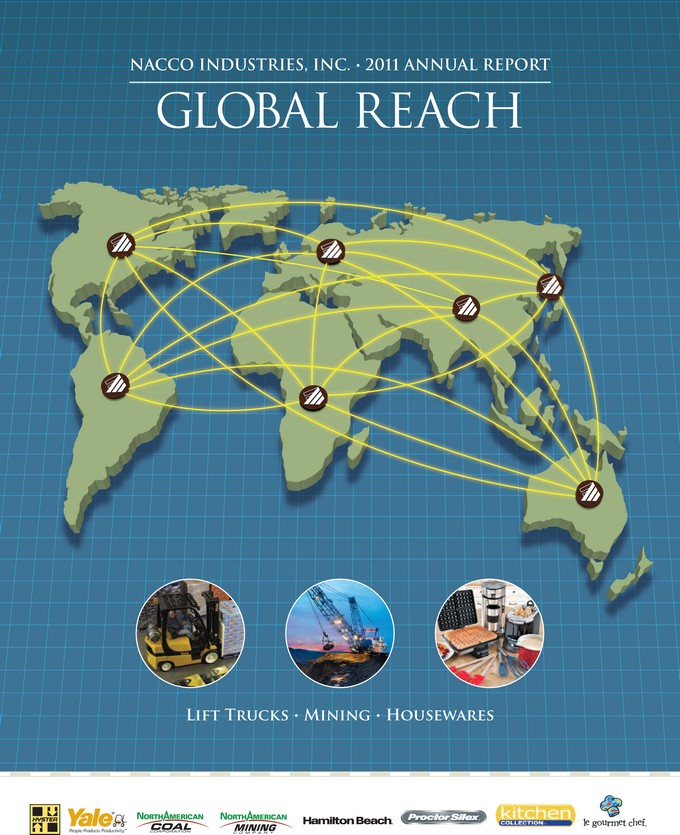
NACCO INDUSTRIES, INC. AT A
GLANCE
|
|
|
|
|
|
|
| |
|
Principal Businesses |
|
Financial Results |
|
Market Positions |
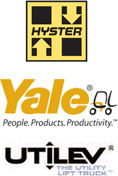
|
|
NACCO Materials Handling Group (“NMHG”) Headquarters: Cleveland, Ohio
NMHG designs, engineers, manufactures, sells and services a comprehensive line of lift trucks and aftermarket parts marketed globally primarily under the
Hyster® and Yale® brand names. Lift trucks and component parts are manufactured in the United States, Northern Ireland, Mexico, The Netherlands, the Philippines, Italy, Japan, Vietnam,
Brazil and China. |
|
NMHG:
Revenues:
$2.5 billion Operating profit: $110.0 million
*Net income:
$82.6 million |
|
NMHG: NMHG is one of
the top five world leaders in the lift truck industry. Lift trucks are
distributed through a worldwide network of independent Hyster® and Yale® dealers. |
|
|
|
|

|
|
Hamilton Beach Brands (“HBB”) Headquarters: Richmond, Virginia HBB is a leading designer, marketer and distributor of small electric household appliances, as well as commercial products for restaurants, bars and hotels.
HBB has a broad portfolio of some of the most recognized and respected brands in the
small electric appliance industry, including Hamilton Beach®, Proctor Silex®, eclectrics®, TrueAir® and Hamilton Beach® Commercial. |
|
HBB:
Revenues:
$493.0 million
Operating profit: $33.8 million
*Net income:
$18.4 million |
|
HBB: HBB is a leading
company in retail and commercial small appliances, with strong share positions in many of the categories in which it competes.
HBB products are primarily distributed through mass merchants, national department stores, wholesale distributors and other retail sales
outlets. |
|
|
|
|
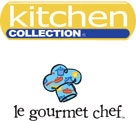
|
|
Kitchen Collection
Headquarters: Chillicothe, Ohio
Kitchen Collection is a national specialty retailer of kitchenware and gourmet foods operating under the Kitchen Collection® and Le Gourmet Chef® store names in outlet and traditional malls throughout the United States. |
|
Kitchen Collection:
Revenues:
$221.2 million
Operating profit: $2.5 million *Net income:
$1.1 million |
|
Kitchen Collection:
Kitchen Collection is the nation’s leading specialty retailer of kitchen and related products in factory outlet malls with 337 stores throughout the
United States in 2011. |
|
|
|
|
|


|
|
North American Coal (“NACoal”) Headquarters: Plano, Texas
North American Coal mines and markets coal primarily as fuel for power generation and provides selected value-added mining services for other natural
resources companies. North American Coal operates four surface coal mining operations and has four additional coal mines under development.
The company also provides dragline mining services operating under the name “North American Mining Company” for independently owned limerock
quarries in Florida. |
|
NACoal:
Revenues:
$81.8 million Operating profit: $35.2 million
*Net income:
$29.4 million |
|
NACoal: North American
Coal is the nation’s largest miner of lignite coal and among the ten largest coal producers. Coal is delivered from developed mines in Mississippi, North Dakota and Texas to adjacent or nearby power plants. |
|
* For purposes of this annual report, discussions about net income refer
to net income attributable to stockholders. |
| Front cover: Left: The Yale® GC050LX internal combustion engine basic lift truck has a lifting capacity of 5,000 pounds. Center: The dragline at The Coteau Properties Company’s
Freedom Mine. Right: A mixture of Hamilton Beach® kitchen products sold at Kitchen Collection® and Le Gourmet Chef® stores |
|
|
|
|
NACCO Industries, Inc. is an operating holding company with subsidiaries in the
following principal industries: lift trucks, small appliances, speciality retail and mining. In 2011, total revenues were $3.3 billion and net income* was $162.1 million.
|
|
|
|
|
| Competitive Advantages |
|
Financial Objectives |
|
Key Strategies |
| NMHG:
• Leading market share positions in the Americas and worldwide
• Highly
recognized Hyster® and Yale® brand names
• Large installed population base of lift trucks; an estimated 785,000 Hyster® and Yale® lift trucks in operation worldwide
• Highly diverse customer base with more than 600 different end-user applications in
more than 700 industries
• Comprehensive global product line
• Strong dealer
network
• Industry-leading national account coverage in the Americas
• Globally
integrated operations with significant economies of scale |
|
NMHG:
Achieve a minimum operating profit margin target of 9 percent at the peak of the market cycle, and an average operating profit margin of 7 percent
mid-cycle |
|
NMHG:
• Innovation in our products and services
- Lowest cost of
ownership
- Application-focused solutions
• Quality and
efficiency
- Improve operational effectiveness while delivering high-quality products
- Continually reduce
manufacturing and supply chain costs - Manufacturing in market of sale
• Sales and service excellence
- Independent dealer
networks with dual brand representation if dealerships meet criteria - Strong national account direct sales group to support large, geographically dispersed customers
• Global coverage with local tailoring of products, services, processes and
systems
• Organizational excellence
- People and processes
development |
|
|
|
| HBB:
• Strong heritage brands with leading market shares
• Strong
relationships with leading retailers • Highly professional and experienced management team
• Successful track record of product line expansion and new product
innovation
• Industry-leading working capital management |
|
HBB: Achieve a minimum operating profit margin target of 10 percent |
|
HBB:
• Innovation in our products
- Invest in deep
understanding of consumer and customer needs - Leverage engineering expertise worldwide to develop innovative solutions that improve everyday living
• Sales and marketing excellence - Professional and efficient sales and marketing
teams, processes and systems
- Building brand equity of our current brands and increasing the number of brands
• Quality and
efficiency
- Ensure operational excellence while delivering high-quality products
- Continually reduce supply
chain costs
• Partnerships with our customers and suppliers
• Organizational
excellence
- People and processes development |
|
|
|
| Kitchen Collection:
• Highly analytical merchandising skills and disciplined operating
controls
• Two well-established, complementary retail store formats–Kitchen Collection® and Le Gourmet Chef® |
|
Kitchen Collection:
Achieve a minimum operating profit margin target of 5 percent |
|
Kitchen Collection:
• Unique, high-quality, widest variety of affordable products in creative store
environments
• Store improvement and expansion
- Kitchen Collection® outlet and traditional mall expansion
- Le Gourmet Chef® outlet mall focus
- Internet channel expansion
• Cost
control
- Continually reduce store and warehousing costs
- Control capital
costs
• Partnerships with our suppliers
• Organizational
excellence
- People and processes development |
|
|
|
| NACoal: • Coal mines provide steady income and cash flow before financing activities and high returns on equity
• Contracts are
structured to minimize exposure to market fluctuations of coal prices • 2.3 billion tons of lignite coal reserves, of which approximately 1.1 billion tons are committed to current customers
• Outstanding
operational and technological mining skills • Highly efficient heavy equipment utilization
• Excellent record of environmental responsibility and employee
safety |
|
NACoal:
Earn a minimum return on capital employed of 13 percent, attain positive Economic Value Income from all existing consolidated mining operations and any
new projects, maintain or increase the profitability of all existing unconsolidated mining operations and achieve substantial income growth by developing new mining ventures |
|
NACoal:
• Mining and reclamation expertise
- Innovative and low
cost - Equipment
maintenance
- Efficient processes and systems
• Safety
focus
• Long-term partnerships with current and future customers
• New business
opportunities
- Domestic and international
- Coal and value-added
mining services
• Organizational excellence
- People
development
- Highly disciplined mine management teams |
SELECTED FINANCIAL & OPERATING
DATA
NACCO INDUSTRIES, INC. AND SUBSIDIARIES
|
|
|
|
|
|
|
|
|
|
|
|
|
|
|
|
|
|
|
|
|
| |
|
Year Ended December 31 |
|
| |
|
2011(1) |
|
|
2010(1) |
|
|
2009(1) |
|
|
2008(1)(2) |
|
|
2007 |
|
| |
|
(In millions, except per share data) |
|
| Operating Statement Data: |
|
|
|
|
|
|
|
|
|
|
|
|
|
|
|
|
|
|
|
|
| Revenues |
|
$ |
3,331.2 |
|
|
$ |
2,687.5 |
|
|
$ |
2,310.6 |
|
|
$ |
3,665.1 |
|
|
$ |
3,590.0 |
|
| Operating profit (loss) |
|
$ |
174.1 |
|
|
$ |
140.3 |
|
|
$ |
59.1 |
|
|
$ |
(389.5 |
) |
|
$ |
139.2 |
|
|
|
|
|
|
|
| Income (loss) from continuing operations |
|
$ |
162.1 |
|
|
$ |
79.4 |
|
|
$ |
8.4 |
|
|
$ |
(439.7 |
) |
|
$ |
89.7 |
|
| Discontinued operations, net-of-tax(3) |
|
|
— |
|
|
|
— |
|
|
|
22.6 |
|
|
|
2.3 |
|
|
|
0.6 |
|
|
|
|
|
|
|
|
|
|
|
|
|
|
|
|
|
|
|
|
|
|
| Net income (loss) |
|
$ |
162.1 |
|
|
$ |
79.4 |
|
|
$ |
31.0 |
|
|
$ |
(437.4 |
) |
|
$ |
90.3 |
|
| Net (income) loss attributable to noncontrolling interest |
|
|
— |
|
|
|
0.1 |
|
|
|
0.1 |
|
|
|
(0.2 |
) |
|
|
0.1 |
|
|
|
|
|
|
|
|
|
|
|
|
|
|
|
|
|
|
|
|
|
|
| Net income (loss) attributable to stockholders |
|
$ |
162.1 |
|
|
$ |
79.5 |
|
|
$ |
31.1 |
|
|
$ |
(437.6 |
) |
|
$ |
90.4 |
|
|
|
|
|
|
|
|
|
|
|
|
|
|
|
|
|
|
|
|
|
|
|
|
|
|
|
|
| Basic Earnings (Loss) per Share: |
|
|
|
|
|
|
|
|
|
|
|
|
|
|
|
|
|
|
|
|
| Income (loss) from continuing operations attributable to stockholders |
|
$ |
19.34 |
|
|
$ |
9.55 |
|
|
$ |
1.03 |
|
|
$ |
(53.12 |
) |
|
$ |
10.87 |
|
| Discontinued operations, net-of-tax(3) |
|
|
— |
|
|
|
— |
|
|
|
2.72 |
|
|
|
0.28 |
|
|
|
0.07 |
|
|
|
|
|
|
|
|
|
|
|
|
|
|
|
|
|
|
|
|
|
|
| Basic earnings (loss) per share |
|
$ |
19.34 |
|
|
$ |
9.55 |
|
|
$ |
3.75 |
|
|
$ |
(52.84 |
) |
|
$ |
10.94 |
|
|
|
|
|
|
|
|
|
|
|
|
|
|
|
|
|
|
|
|
|
|
|
|
|
|
|
|
| Diluted Earnings (Loss) per Share: |
|
|
|
|
|
|
|
|
|
|
|
|
|
|
|
|
|
|
|
|
| Income (loss) from continuing operations attributable to stockholders |
|
$ |
19.28 |
|
|
$ |
9.53 |
|
|
$ |
1.03 |
|
|
$ |
(53.12 |
) |
|
$ |
10.86 |
|
| Discontinued operations, net-of-tax(3) |
|
|
— |
|
|
|
— |
|
|
|
2.72 |
|
|
|
0.28 |
|
|
|
0.07 |
|
|
|
|
|
|
|
|
|
|
|
|
|
|
|
|
|
|
|
|
|
|
| Diluted earnings (loss) per share |
|
$ |
19.28 |
|
|
$ |
9.53 |
|
|
$ |
3.75 |
|
|
$ |
(52.84 |
) |
|
$ |
10.93 |
|
|
|
|
|
|
|
|
|
|
|
|
|
|
|
|
|
|
|
|
|
|
|
|
|
|
|
|
| Per Share and Share Data: |
|
|
|
|
|
|
|
|
|
|
|
|
|
|
|
|
|
|
|
|
| Cash dividends |
|
$ |
2.120 |
|
|
$ |
2.085 |
|
|
$ |
2.068 |
|
|
$ |
2.045 |
|
|
$ |
1.980 |
|
| Market value at December 31 |
|
$ |
89.22 |
|
|
$ |
108.37 |
|
|
$ |
49.80 |
|
|
$ |
37.41 |
|
|
$ |
99.69 |
|
| Stockholders’ equity at December 31 |
|
$ |
68.81 |
|
|
$ |
53.69 |
|
|
$ |
47.82 |
|
|
$ |
43.05 |
|
|
$ |
107.80 |
|
|
|
|
|
|
|
| Actual shares outstanding at December 31 |
|
|
8.374 |
|
|
|
8.333 |
|
|
|
8.294 |
|
|
|
8.286 |
|
|
|
8.269 |
|
| Basic weighted average shares outstanding |
|
|
8.383 |
|
|
|
8.328 |
|
|
|
8.290 |
|
|
|
8.281 |
|
|
|
8.263 |
|
| Diluted weighted average shares outstanding |
|
|
8.408 |
|
|
|
8.344 |
|
|
|
8.296 |
|
|
|
8.281 |
|
|
|
8.272 |
|
|
|
|
|
|
|
| Balance Sheet Data at December 31: |
|
|
|
|
|
|
|
|
|
|
|
|
|
|
|
|
|
|
|
|
| Cash |
|
$ |
338.6 |
|
|
$ |
261.9 |
|
|
$ |
256.2 |
|
|
$ |
138.2 |
|
|
$ |
281.2 |
|
| Total assets |
|
$ |
1,801.4 |
|
|
$ |
1,658.3 |
|
|
$ |
1,488.7 |
|
|
$ |
1,687.9 |
|
|
$ |
2,427.3 |
|
| Long-term debt |
|
$ |
129.1 |
|
|
$ |
355.3 |
|
|
$ |
377.6 |
|
|
$ |
400.3 |
|
|
$ |
439.3 |
|
| Stockholders’ equity |
|
$ |
576.2 |
|
|
$ |
447.4 |
|
|
$ |
396.6 |
|
|
$ |
356.7 |
|
|
$ |
891.4 |
|
| (1) |
In 2006, NACCO initiated litigation in the Delaware Chancery Court against Applica Incorporated (“Applica”) and individuals and entities affiliated with
Applica’s shareholder, Harbinger Capital Partners Master Fund, Ltd. The litigation alleged a number of contract and tort claims against the defendants related to the failed transaction with Applica, which had been previously announced. On
February 14, 2011, the parties to this litigation entered into a settlement agreement. The settlement agreement provided for, among other things, the payment of $60 million to NACCO and dismissal of the lawsuit with prejudice. The payment was
received in February 2011. Litigation costs related to the failed transaction with Applica were $2.8 million, $18.8 million, $1.1 million and $0.8 million in 2011, 2010, 2009 and 2008, respectively. |
| (2) |
During 2008, NACCO’s stock price significantly declined compared with previous periods and the Company’s market value of equity was below its book value of
tangible assets and book value of equity. The Company performed an impairment test, which indicated that goodwill and certain other intangibles were impaired at December 31, 2008. Therefore, the Company recorded a non-cash impairment charge of
$435.7 million in 2008. |
| (3) |
During 2009, the Company’s North American Coal subsidiary completed the sale of certain assets of the Red River Mining Company. The results of operations of Red
River for 2009 and all prior periods have been reclassified to reflect Red River’s operating results as discontinued operations. |
This Annual Report contains references to non-GAAP financial measures. Presentations of, and quantitative reconciliations to, the most directly comparable financial measures calculated and presented in
accordance with U.S. generally accepted accounting principles (“GAAP”) appear on page two and page eighteen. For certain pre-tax disclosures included in the “To Our Stockholders” letter beginning on page three, the resulting
after-tax amount and the related income tax amount have been included. Certain after-tax amounts are considered non-GAAP measures in accordance with Regulation G. Management believes that after-tax information is useful in analyzing the
Company’s net income.
ONE
|
|
|
|
|
|
|
|
|
|
|
|
|
|
|
|
|
|
|
|
|
| |
|
Year Ended December 31 |
|
| |
|
2011(1) |
|
|
2010(1) |
|
|
2009(1) |
|
|
2008(1)(2) |
|
|
2007 |
|
| |
|
(In millions, except employee data) |
|
| Cash Flow Data: |
|
|
|
|
|
|
|
|
|
|
|
|
|
|
|
|
|
|
|
|
| Operating Activities |
|
|
|
|
|
|
|
|
|
|
|
|
|
|
|
|
|
|
|
|
| NACCO Materials Handling Group |
|
$ |
54.6 |
|
|
$ |
47.5 |
|
|
$ |
115.9 |
|
|
$ |
(27.3 |
) |
|
$ |
34.6 |
|
| Hamilton Beach Brands |
|
|
24.2 |
|
|
|
15.0 |
|
|
|
35.5 |
|
|
|
18.0 |
|
|
|
19.5 |
|
| Kitchen Collection |
|
|
4.9 |
|
|
|
6.3 |
|
|
|
5.4 |
|
|
|
(6.4 |
) |
|
|
(10.9 |
) |
| North American Coal Corporation |
|
|
31.7 |
|
|
|
25.9 |
|
|
|
42.0 |
|
|
|
23.2 |
|
|
|
44.7 |
|
| NACCO and Other |
|
|
39.8 |
|
|
|
(31.6 |
) |
|
|
(41.8 |
) |
|
|
(2.6 |
) |
|
|
(6.5 |
) |
|
|
|
|
|
|
|
|
|
|
|
|
|
|
|
|
|
|
|
|
|
| Provided by operating activities |
|
$ |
155.2 |
|
|
$ |
63.1 |
|
|
$ |
157.0 |
|
|
$ |
4.9 |
|
|
$ |
81.4 |
|
|
|
|
|
|
|
|
|
|
|
|
|
|
|
|
|
|
|
|
|
|
|
|
|
|
|
|
| Investing Activities |
|
|
|
|
|
|
|
|
|
|
|
|
|
|
|
|
|
|
|
|
| NACCO Materials Handling Group |
|
$ |
(15.9 |
) |
|
$ |
(8.5 |
) |
|
$ |
5.8 |
|
|
$ |
(37.5 |
) |
|
$ |
(33.9 |
) |
| Hamilton Beach Brands |
|
|
(3.7 |
) |
|
|
(2.2 |
) |
|
|
(2.1 |
) |
|
|
(5.7 |
) |
|
|
(3.7 |
) |
| Kitchen Collection |
|
|
(2.3 |
) |
|
|
(2.7 |
) |
|
|
(1.1 |
) |
|
|
(6.0 |
) |
|
|
(3.9 |
) |
| North American Coal Corporation |
|
|
(10.7 |
) |
|
|
6.9 |
|
|
|
34.5 |
|
|
|
(15.9 |
) |
|
|
(18.2 |
) |
| NACCO and Other |
|
|
(0.1 |
) |
|
|
0.7 |
|
|
|
(14.0 |
) |
|
|
(6.3 |
) |
|
|
(0.2 |
) |
|
|
|
|
|
|
|
|
|
|
|
|
|
|
|
|
|
|
|
|
|
| Provided by (used for) investing activities |
|
$ |
(32.7 |
) |
|
$ |
(5.8 |
) |
|
$ |
23.1 |
|
|
$ |
(71.4 |
) |
|
$ |
(59.9 |
) |
|
|
|
|
|
|
|
|
|
|
|
|
|
|
|
|
|
|
|
|
|
|
|
|
|
|
|
| Cash Flow before Financing Activities(4) |
|
|
|
|
|
|
|
|
|
|
|
|
|
|
|
|
|
|
|
|
| NACCO Materials Handling Group |
|
$ |
38.7 |
|
|
$ |
39.0 |
|
|
$ |
121.7 |
|
|
$ |
(64.8 |
) |
|
$ |
0.7 |
|
| Hamilton Beach Brands |
|
|
20.5 |
|
|
|
12.8 |
|
|
|
33.4 |
|
|
|
12.3 |
|
|
|
15.8 |
|
| Kitchen Collection |
|
|
2.6 |
|
|
|
3.6 |
|
|
|
4.3 |
|
|
|
(12.4 |
) |
|
|
(14.8 |
) |
| North American Coal Corporation |
|
|
21.0 |
|
|
|
32.8 |
|
|
|
76.5 |
|
|
|
7.3 |
|
|
|
26.5 |
|
| NACCO and Other |
|
|
39.7 |
|
|
|
(30.9 |
) |
|
|
(55.8 |
) |
|
|
(8.9 |
) |
|
|
(6.7 |
) |
|
|
|
|
|
|
|
|
|
|
|
|
|
|
|
|
|
|
|
|
|
| Consolidated Cash Flow before Financing Activities |
|
$ |
122.5 |
|
|
$ |
57.3 |
|
|
$ |
180.1 |
|
|
$ |
(66.5 |
) |
|
$ |
21.5 |
|
|
|
|
|
|
|
|
|
|
|
|
|
|
|
|
|
|
|
|
|
|
|
|
|
|
|
|
| Provided by (used for) financing activities |
|
$ |
(42.0 |
) |
|
$ |
(43.3 |
) |
|
$ |
(64.1 |
) |
|
$ |
(83.2 |
) |
|
$ |
64.4 |
|
|
|
|
|
|
|
| Other Data: |
|
|
|
|
|
|
|
|
|
|
|
|
|
|
|
|
|
|
|
|
| Adjusted EBITDA(5) |
|
$ |
226.7 |
|
|
$ |
192.6 |
|
|
$ |
112.6 |
|
|
$ |
107.4 |
|
|
$ |
201.7 |
|
|
|
|
|
|
|
| Total employees at December 31(6) |
|
|
9,300 |
|
|
|
8,900 |
|
|
|
8,600 |
|
|
|
9,500 |
|
|
|
10,600 |
|
| (4) |
Cash Flow before Financing Activities is equal to net cash provided by operating activities less net cash used for investing activities. |
| (5) |
Adjusted EBITDA is provided solely as a supplemental disclosure with respect to liquidity because management believes it provides useful information regarding a
company’s ability to service its indebtedness. Adjusted EBITDA does not represent cash flow from operations, as defined by U.S. GAAP. You should not consider Adjusted EBITDA as a substitute for net income or net loss, or as an indicator of our
operating performance or whether cash flows will be sufficient to fund our cash needs. NACCO defines Adjusted EBITDA as income before Applica settlement and litigation charges, goodwill and other intangible assets impairment charges, income taxes,
non-controlling interest (income) expense and discontinued operations plus net interest expense and depreciation, depletion and amortization expense. Adjusted EBITDA is not a measurement under U.S.GAAP and is not necessarily comparable with
similarly titled measures of other companies. Net cash flows from operating, investing and financing activities as determined using U.S. GAAP are presented above. A reconciliation of cash flow provided by operating activities to Adjusted EBITDA is
presented below. |
| (6) |
Includes employees of the unconsolidated mining subsidiaries and excludes employees of Red River. |
|
|
|
|
|
|
|
|
|
|
|
|
|
|
|
|
|
|
|
|
|
| |
|
Year Ended December 31 |
|
| |
|
2011(1) |
|
|
2010(1) |
|
|
2009(1) |
|
|
2008(1)(2) |
|
|
2007 |
|
| |
|
(In millions) |
|
| Reconciliation of cash flow from operations to Adjusted EBITDA(5) |
|
|
|
|
|
|
|
|
|
|
|
|
|
|
|
|
|
|
|
|
| Cash flow from operations |
|
$ |
155.2 |
|
|
$ |
63.1 |
|
|
$ |
157.0 |
|
|
$ |
4.9 |
|
|
$ |
81.4 |
|
| Change in working capital items |
|
|
73.6 |
|
|
|
48.9 |
|
|
|
(114.5 |
) |
|
|
96.6 |
|
|
|
77.2 |
|
| Applica settlement and litigation costs |
|
|
(57.2 |
) |
|
|
18.8 |
|
|
|
1.1 |
|
|
|
0.8 |
|
|
|
— |
|
| Gain (loss) on sale of assets and businesses |
|
|
0.8 |
|
|
|
(5.9 |
) |
|
|
10.0 |
|
|
|
0.1 |
|
|
|
1.3 |
|
| Discontinued operations |
|
|
— |
|
|
|
— |
|
|
|
8.4 |
|
|
|
(4.6 |
) |
|
|
(2.0 |
) |
| Restructuring (charges) reversals |
|
|
— |
|
|
|
1.9 |
|
|
|
(9.3 |
) |
|
|
(9.1 |
) |
|
|
(8.6 |
) |
| Difference between deferred income taxes and total tax provision |
|
|
37.3 |
|
|
|
6.9 |
|
|
|
(4.2 |
) |
|
|
(1.6 |
) |
|
|
19.1 |
|
| Other non-cash items |
|
|
(5.4 |
) |
|
|
34.1 |
|
|
|
35.1 |
|
|
|
(12.7 |
) |
|
|
4.6 |
|
| Interest expense, net |
|
|
22.4 |
|
|
|
24.8 |
|
|
|
29.0 |
|
|
|
33.0 |
|
|
|
28.7 |
|
|
|
|
|
|
|
|
|
|
|
|
|
|
|
|
|
|
|
|
|
|
| Adjusted EBITDA(5) |
|
$ |
226.7 |
|
|
$ |
192.6 |
|
|
$ |
112.6 |
|
|
$ |
107.4 |
|
|
$ |
201.7 |
|
|
|
|
|
|
|
|
|
|
|
|
|
|
|
|
|
|
|
|
|
|
|
|
|
|
|
|
| Calculation of Adjusted EBITDA(5) |
|
|
|
|
|
|
|
|
|
|
|
|
|
|
|
|
|
|
|
|
| Net income (loss) attributable to stockholders |
|
$ |
162.1 |
|
|
$ |
79.5 |
|
|
$ |
31.1 |
|
|
$ |
(437.6 |
) |
|
$ |
90.4 |
|
| Applica settlement and litigation costs |
|
|
(57.2 |
) |
|
|
18.8 |
|
|
|
1.1 |
|
|
|
0.8 |
|
|
|
— |
|
| Goodwill and other intangible assets impairment charges |
|
|
— |
|
|
|
— |
|
|
|
— |
|
|
|
435.7 |
|
|
|
— |
|
| Discontinued operations, net of tax |
|
|
— |
|
|
|
— |
|
|
|
(22.6 |
) |
|
|
(2.3 |
) |
|
|
(0.6 |
) |
| Noncontrolling interest (income) loss |
|
|
— |
|
|
|
(0.1 |
) |
|
|
(0.1 |
) |
|
|
0.2 |
|
|
|
(0.1 |
) |
| Income tax provision |
|
|
51.7 |
|
|
|
17.4 |
|
|
|
20.5 |
|
|
|
18.7 |
|
|
|
24.3 |
|
| Interest expense |
|
|
24.5 |
|
|
|
27.4 |
|
|
|
32.2 |
|
|
|
40.6 |
|
|
|
40.7 |
|
| Interest income |
|
|
(2.1 |
) |
|
|
(2.6 |
) |
|
|
(3.2 |
) |
|
|
(7.6 |
) |
|
|
(12.0 |
) |
| Depreciation, depletion and amortization expense |
|
|
47.7 |
|
|
|
52.2 |
|
|
|
53.6 |
|
|
|
58.9 |
|
|
|
59.0 |
|
|
|
|
|
|
|
|
|
|
|
|
|
|
|
|
|
|
|
|
|
|
| Adjusted EBITDA(5) |
|
$ |
226.7 |
|
|
$ |
192.6 |
|
|
$ |
112.6 |
|
|
$ |
107.4 |
|
|
$ |
201.7 |
|
|
|
|
|
|
|
|
|
|
|
|
|
|
|
|
|
|
|
|
|
|
TWO
|
|
|
|
|
|
|
TO OUR STOCKHOLDERS |
|
|
|
|
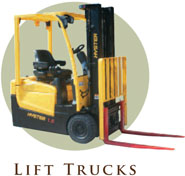
|
|
Introduction
The global reach of NACCO Industries, Inc. and its subsidiaries helped the Company achieve financial results in 2011 that were
substantially higher than 2010. These strong results were driven primarily by improvements in global lift truck markets and enhanced by a significant one-time event.
The year began with the settlement of litigation initiated by NACCO in 2006 against Applica Incorporated (“Applica”) and
individuals and entities affiliated with Applica’s shareholder, Harbinger Capital Partners Master Fund I Ltd. In February 2011, NACCO received a payment of $60 million ($39.0 million after taxes of $21.0 million) in connection with this
settlement. The settlement was a favorable lead-in to
a strong financial year. As we predicted last year, lift truck markets around the world continued to improve in 2011, resulting in significant volume increases at NACCO Materials Handling Group (“NMHG”). However, most of this market
improvement occurred in the first three quarters of the year, and as the year came to a close, lift truck market growth began to moderate. The improvement in the lift truck markets at NMHG was tempered by weak mass-consumer markets at Hamilton Beach
Brands (“HBB”) and Kitchen Collection and reduced customer requirements for coal and limerock at The North American Coal Corporation (“NACoal”), as well as globally increasing commodity costs and adverse changes in foreign
currency exchange rates primarily at NMHG. The mid-market consumer, which is the primary consumer for HBB and Kitchen Collection, continued to struggle with high unemployment rates and financial concerns. At NACoal, excess rain and snow in the
Western United States |
|
resulted in more hydropower, rather than coal, being utilized to create energy, and a customer’s continued struggle
with power plant operation issues caused a number of unplanned outages throughout the year. In addition, the southern Florida construction market, which uses limerock, remained weak. Finally, adding to the lower market demand, NACoal’s contract
to supply coal to the San Miguel power plant expired at the end of 2010. Given 2011 market conditions, excellent results were achieved at NMHG but results at HBB, Kitchen Collection and NACoal were disappointing. Consolidated revenues for NACCO increased to $3.3 billion in
2011 from $2.7 billion in 2010, with the increase primarily driven by volume improvements at NMHG partially offset by fewer deliveries by NACoal and reduced volumes due to fewer retail placements at HBB.
Net income(1) increased substantially to $162.1 million, or $19.28 per diluted
share, in 2011 from $79.5 million, or $9.53 per diluted share, in 2010. Net income for 2011 includes the receipt of the Applica litigation settlement in the first quarter of 2011. This settlement was partially offset by litigation costs of $2.8
million, or $1.8 million after taxes of $1.0 million, also incurred in the first quarter of 2011. Net income in 2010 includes expenses of $18.8 million, or $12.2 million after tax of $6.6 million, for Applica litigation costs. Excluding the
settlement and litigation costs, consolidated adjusted income(2) for the year ended December 31, 2011 was $124.9 million, or $14.85 per diluted share, compared with consolidated adjusted income in 2010 of $91.7 million, or $10.99 per diluted
share. |
|

|
|
|
|
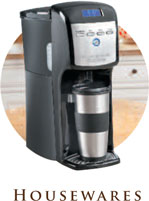
|
|
|
| Top: The new Hyster® J30-40XNT 3-wheel electric lift truck, with a lifting capacity of 3,000 to 4,000 pounds, has a compact design and
tight turning radius for limited space.
Center: Early morning mining operations at The Coteau Properties Company’s Freedom Mine in North Dakota.
Bottom: The newest model of the
Hamilton Beach® BrewStation® 12-cup coffee maker. |
|
|
|
|
(1) For purposes of this annual report, discussions about net income refer to net income attributable
to stockholders. (2) “Consolidated adjusted income” in this letter refers to net
income results that exclude the Applica settlement and related litigation costs. (For reconciliations from GAAP results to the adjusted non-GAAP results, see page eighteen.) Management believes a discussion of consolidated adjusted income is more
reflective of NACCO’s underlying business operations and assists investors in better understanding the results of operations of NACCO and its subsidiaries. |
THREE
|
|
|
|
|
| NMHG, HBB and NACoal all had strong returns on capital employed(3) (“ROTCE”) on a net debt basis of 26.4 percent, 27.7
percent and 17.1 percent, respectively, with only Kitchen Collection falling below an acceptable level at 3.1 percent. Consolidated NACCO’s ROTCE, excluding the Applica litigation settlement, was 22.2 percent.
In addition to the substantial increase in net income, each of
NACCO’s subsidiaries generated strong positive cash flow before financing activities totaling $122.5 million in 2011, much higher than the $57.3 million generated in 2010. Also during 2011, NACoal put in place a favorable credit agreement and
paid substantial dividends of $72.9 million to NACCO, while HBB voluntarily prepaid $60 million on its term loan. NACCO will continue to focus on maximizing cash flow before financing activities and expects continued strong cash flow generation from
all businesses in 2012. NACCO’s stock price,
like the overall stock market, has been very volatile in the past year – reaching as high as $132.69 in February 2011 and as low as $56.53 in October 2011, with an average of $91.56 for the year. Given the Company’s strong position in the
industries it competes in, NACCO hopes for enhanced valuation as it continues to successfully execute its strategies to enable its subsidiaries to reach their financial targets. NACCO’s Board of Directors in November 2011 approved the
repurchase of up to $50 million of the Company’s outstanding Class A common stock. The authorization for the repurchase program expires on December 31, 2012. The share repurchase program does not require the Company to acquire any specific
number of shares. As of December 31, 2011, NACCO had purchased 24,406 shares at an average price of $84.53 per share.
Market conditions for NACCO’s subsidiaries are moderating or uncertain at this time and each subsidiary is proceeding cautiously
and monitoring |
|
conditions closely. The global lift truck market is expected to moderate in 2012, resulting in volumes at NMHG comparable to 2011. While
continued improvement in consumer confidence is expected, selling to the mass-market consumer is expected to remain challenging at HBB and Kitchen Collection. In addition, rising commodity costs are expected to create margin pressures at HBB and
NMHG since recovering these cost increases through price increases in the prevailing market conditions will be challenging. Coal deliveries are expected to be higher in 2012, provided NACoal’s customers continue to achieve currently planned
power plant operating levels, but the limerock market in southern Florida is expected to continue to be depressed by weak local housing and construction markets. In light of these anticipated market conditions, the Company expects earnings at NMHG
to be down compared with 2011 but up modestly at the other subsidiaries, resulting in an overall decrease in consolidated earnings, excluding the Applica settlement.
Subsidiary Financial Objectives
Each of NACCO’s subsidiary companies has specific long-term financial objectives (see below for specific goals). In 2011, NACoal
met its ROTCE objective. NMHG made significant progress toward its operating profit margin target as global markets improved, volumes increased and costs were contained. Despite a significant |
|
improvement in economic performance, NMHG is still well below its operating profit margin target. Achieving NMHG’s target operating profit margin will require higher factory
capacity utilization brought about by increases in market share and achieving target margins on certain products, particularly smaller internal combustion engine products. It is difficult to provide a timetable for achieving NMHG’s financial
target. However, market improvements, NMHG’s programs and substantial operating leverage have established a strong platform for achieving NMHG’s operating profit margin target in the future. HBB had sound operating profit but fell well
below its long-term operating profit margin target. Kitchen Collection also fell well below its target. At both HBB and Kitchen Collection, operating profits and related operating profit margins declined compared with 2010. Looking forward, HBB and
the Kitchen Collection® store format are expected to continue to produce sound results but will need additional
sales volumes to achieve their targets. The Le Gourmet Chef® stores are not expected to achieve their target
objective until sales volumes increase and additional underperforming stores have been closed. As each of NACCO’s subsidiaries proceeds with specific programs designed to reach its financial objectives and market conditions continue to improve,
the Company expects that its subsidiaries’ operating fundamentals will position each to achieve or maintain its long-term financial goals. |
| |
SUBSIDIARY
FINANCIAL OBJECTIVES • NMHG: Achieve an operating profit margin of 9 percent at the peak of the market cycle, and an average operating profit margin of 7 percent mid-cycle.
• HBB:
Achieve a minimum operating profit margin of 10 percent. • Kitchen Collection: Achieve a minimum operating profit margin of 5 percent.
• NACoal: Earn a minimum return on capital employed of 13 percent, attain
positive Economic Value Income from all existing consolidated mining operations and any new projects, maintain or increase the profitability of all existing unconsolidated mining operations and achieve substantial income growth by developing new
mining ventures.
• All businesses: Generate substantial cash flow before financing
activities. |
|
(3) See page eighteen for the calculation of return on capital employed. |
FOUR
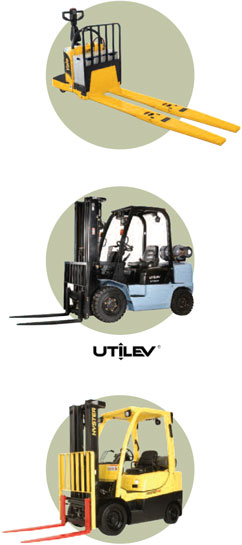
Above from top: Yale’s MPE060-080VG motorized hand truck has a lifting
capacity of 6,000 to 8,000 pounds. NMHG’s new range of UTILEV® brand forklift trucks, which are basic
forklift trucks that meet the needs of low-intensity users. The new Hyster® S50CT internal combustion engine,
cushion tire lift truck has a lifting capacity of 5,000 pounds and is targeted at the medium-duty segment.
At right, from top: The new European Hyster® 2.5CT internal combustion engine, pneumatic tire lift truck, with lifting capacities of 2,000 to 2,500 kilograms, targeted for low-intensity or medium-duty
operations. The European Hyster® H4.0FT Fortens® lift truck, upgraded with new Hyster technologies, has a lifting capacity of 4,000 kilograms.
NACCO MATERIALS
HANDLING GROUP
2011 Results
NMHG has engineering, manufacturing, sales and distribution operations throughout the world serving a global customer base. The company
is continually seeking to expand its reach by enhancing its dealer network in individual markets and sourcing components from all over the globe, while executing its strategy of manufacturing in the market of sale. However, while the business
benefits from this global reach, the company is also susceptible to fluctuating currencies and market conditions in the countries in which it operates. The global market recovery in the materials handling industry, which began in 2010, continued
into 2011. These improvements resulted in a 41 percent increase in revenues from $1.8 billion in 2010 to $2.5 billion in 2011, driven by a 33 percent increase in new unit shipments, as well as increased part sales. Improved volumes, combined with
price increases implemented in late 2010 and early 2011 that more than offset material cost increases, manufacturing efficiencies obtained from increased volumes and tight control of expenses and the company’s lean and cautious attitude in
running the business, helped drive the substantial improvement in net income from $32.4 million in 2010 to $82.6 million in 2011. Operating profit margins improved from 2.6 percent in 2010 to 4.3 percent in 2011, a significant improvement but still
well below NMHG’s operating profit margin target of a 7 percent average operating profit margin at the mid-point of the market cycle. This substantial improvement occurred despite the full restoration of compensation and benefits at the
beginning of 2011. NMHG also generated strong cash flow before financing activities of $38.7 million in 2011, comparable to the $39.0 million generated in 2010.
Continued market improvement in 2011 resulted in a number of other positive developments during the year. A strong, stable backlog developed and supplier constraints dissipated, resulting in more
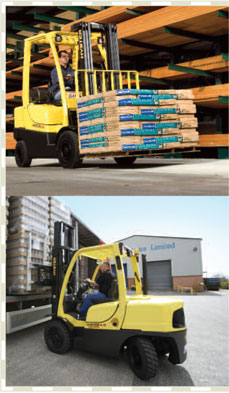
normal lead times. NMHG continued to strengthen its distribution network by adding strong
independent dealers in Eastern Europe, adding more dual brand representation by dealers and replacing underperforming dealerships. In addition, the company entered into agreements with two dealers in India to enhance distribution by permitting
certain Hyster® and Yale® lift trucks to be manufactured in India under license. Major enhancements were also made to many of NMHG’s product lines, and a new brand of forklift truck was
offered to a market sector NMHG had not effectively competed in previously. In addition, to strengthen innovation and execution of advanced product development programs, NMHG opened a new Engineering Concept Centre near NMHG’s European
headquarters in the United Kingdom.
FIVE
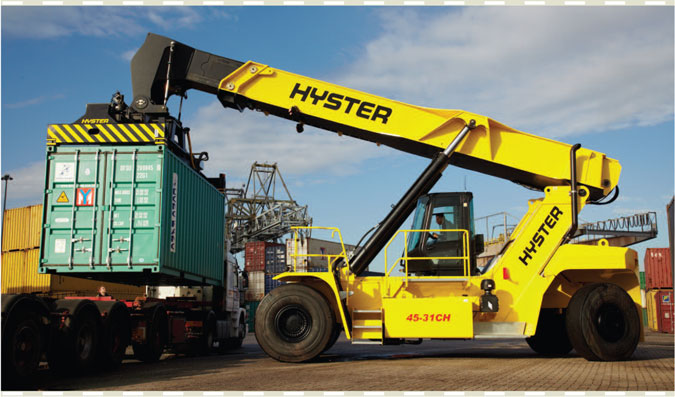
The new low emission, Tier 4 compliant,
Hyster® RS45-31CH ReachStacker, for port and terminal applications, has a lifting capacity of up to 99,000
pounds and the capability to stack containers five high in the front row
LIFT TRUCKS
Finally, as a result of strategic programs put in place to strengthen NMHG’s
manufacturing capabilities and counteract the downturn beginning in 2008, two of NMHG’s plants received awards in 2011. NMHG’s Berea, Kentucky, plant received Plant Engineering’s “Top Plant” award for coming out of the
recession stronger than it went in by betting on its employees to help strengthen the organization. NMHG’s Craigavon, Northern Ireland, plant received the Northern Ireland Quality Award for its passionate pursuit of quality excellence to
maximize the potential of its business, improve productivity and deliver more with less.
Nonetheless, 2011 was not without its challenges. Material costs continued to increase as
a result of rising commodity costs, which triggered the implementation of price increases. Currency rates also moved unfavorably in 2011 as a result of the weak euro and a strengthening of the Japanese yen. Finally, in the fourth quarter of the
year, NMHG began to see a softening in global market demand for forklift trucks.
Outlook for 2012
NMHG expects global lift truck markets to moderate in 2012, with volumes comparable to 2011 in the Americas and Asia-Pacific and modest
declines in Europe, particularly Western Europe, and China.
Nonetheless, NMHG anticipates a slight increase in unit booking and shipment levels in 2012 compared with 2011, primarily as a result of new product introductions. Backlog and parts volumes are
also expected to remain relatively steady in 2012.
While European financial concerns continue, the sustainability of the
market recovery remains in question. As a result, NMHG plans to maintain conservative production levels and will do so until it is confident the recovery is sustainable. Overall, NMHG’s product development, supply chain, manufacturing processes
and quality and reliability programs are performing at expected levels and are
SIX
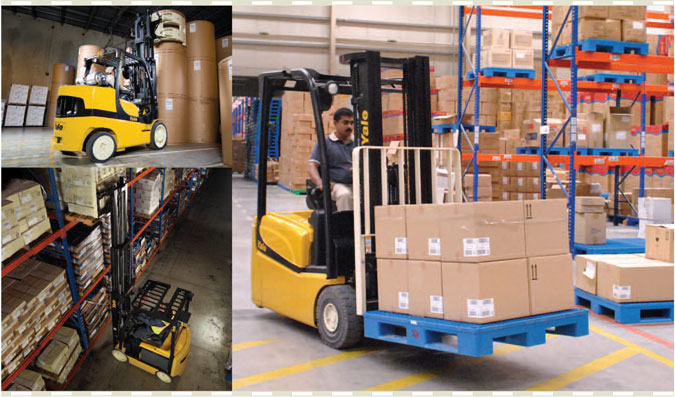
Clockwise from bottom left: One of Yale’s new electric-rider lift truck
series, the Yale® ERC-VA cushion tire series, has lifting capacities of 3,000 to 4,000 pounds. These trucks have
been designed for overall productivity at lower costs; the four-wheel lift truck is shown here. This Yale®
Veracitor® GC155VX internal combustion engine lift truck has a basic lifting capacity of 15,500 pounds and is
shown here with a paper roll clamp attachment. Another series in Yale’s new electric-rider lift truck series, the
Yale® ERP-VT three-wheel pneumatic tire lift truck, has a zero-turn radius and a lifting capacity of 3,000 to
4,000 pounds.
now focused on continuous improvement. NMHG’s challenges in 2012 will be to enhance distribution
effectiveness to generate additional market share, and to ensure that customer applications are properly served with the right products at the right prices to achieve target margins, especially in the internal combustion engine product lines where
NMHG now offers utility, medium-duty and premium heavy-duty models. As a key component of its efforts to enhance market share in 2012, NMHG expects to continue its program of strengthening its distribution network by adding strong independent
dealers, allowing more dual brand representation by dealers and replacing underperforming dealerships. NMHG also expects to enhance market share through new product introductions to fulfill key market segments,
such as expanded distribution of a utility internal combustion engine lift truck for low-intensity applications in markets around the world.
NMHG will increase prices, as necessary, in response to rising costs, but in a manner that does not erode its competitive position.
Although commodity costs stabilized and decreased slightly at the end of 2011, these markets are highly volatile and commodity costs, particularly for steel, are expected to increase in 2012. Price increases already implemented and announced in the
first quarter of 2012 are expected to offset a significant portion of anticipated higher material costs over time. The company will also continue to monitor economic conditions and the resulting effects on costs to determine the need for any future
price increases.
Foreign currency movements are also expected to affect results negatively. A stronger
Japanese yen is anticipated to affect both Europe’s and the Americas’ profitability adversely. The weakening euro is also expected to affect European operations negatively, while favorably affecting results in the Americas. However, NMHG
did enter into foreign currency exchange contracts at favorable rates in 2011, which are expected to moderately mitigate the effect of currency fluctuations in 2012.
Overall, net income is expected to decline materially in 2012 compared with 2011 as a result of the absence of one-time items, including the elimination of certain post-retirement benefits, which
benefited 2011 results, adverse currency movements, an anticipated shift in sales
SEVEN
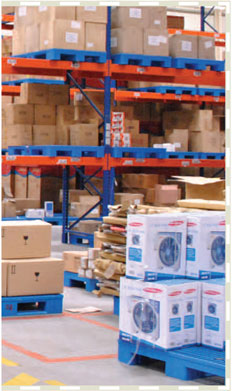
mix to lower-margin markets and higher marketing and employee-related costs. The decrease in net income is expected to
occur primarily in the first half of the year, with modest improvements expected in the second half of 2012 compared with the second half of 2011. Results are expected to be down in all major markets except Brazil. Significant improvements in Brazil
are expected to be offset by a decline in the North America results. Cash flow before financing activities for the full year 2012 is expected to be higher than 2011 despite a significant increase in capital expenditures in 2012 compared with 2011.
Longer-Term Perspective
NMHG remains committed to its vision of being a leading globally integrated designer, manufacturer and marketer of a complete range of high-quality, application-tailored lift trucks, offering the lowest
cost
of ownership, outstanding parts and service support and the best overall value. NMHG made significant progress in 2011 and expects to continue that progress in 2012. The company believes it is
well-positioned to maintain its global competitiveness. However, as markets begin to moderate, NMHG will be particularly focused on achieving its financial targets and furthering its global reach. As such, NMHG is focused on five strategic goals
which are designed to enhance market share: (1) offering the lowest cost of ownership, (2) understanding customer needs at the product and after-market levels, (3) further penetrating the warehouse market, (4) achieving leadership in independent
distribution through broad account coverage of the market and strong dealers throughout the world, and (5) expanding in Asia by offering lift trucks that meet the needs of that market and strengthening partner relationships.
The company’s product pipeline is on track to produce a continuous stream of new product innovations and
product introductions over the next several years to meet customer needs and provide the lowest cost of ownership. The products in the pipeline are expected to enhance NMHG’s competitiveness and market share. In 2011, NMHG launched two new
electric-rider lift trucks and expects to launch the final two models in this electric-rider lift truck program in the first half of 2012. In addition, NMHG successfully launched a new medium-duty internal combustion engine lift truck in Europe in
the third quarter of 2011, complementing a product launched in the Americas in July 2010. In 2011, the company also introduced, into selected Latin American markets, a new range of UTILEV® brand forklift trucks, which are basic forklift trucks that meet the needs of low-intensity users. This new internal combustion engine series of utility lift trucks
is expected to be introduced into other global markets in 2012. With the addition of the UTILEV® forklift truck
range, NMHG is now able to provide coverage to all segments of the market — utility, medium-duty and heavy-duty.
NMHG currently has truck engine systems that meet the emission requirements for the
regions of the world in which it does business. However, new, stricter diesel emission regulations are currently affecting all lift truck manufacturers, and some of these new regulations go into effect in 2012 in certain global markets. NMHG has
been working to ensure these new requirements are satisfied in a cost-effective manner, but the company expects these new regulations will increase the cost of the trucks, which in turn is likely to lead to substantial price increases for certain
trucks beginning with 2012 deliveries. As a result of the stricter regulations, NMHG expects to launch a range of lift trucks in 2012, beginning with the Big Truck product line, which will include engine systems that meet the new emission
requirements.
As part of NMHG’s efforts to further penetrate the warehouse equipment market, the company plans to
focus on direct sales to major accounts as well as product enhancements in the Americas. In addition, NMHG expects to launch a new Reach Truck for the European warehouse market in early 2013.
In the years ahead, the company expects to continue to work aggressively to meet evolving market requirements in
all product segments of the market and has already begun making progress in achieving its goals. In 2011, Hyster Company was ranked No. 1 in brand satisfaction and Hyster® lift trucks were ranked No. 1 in the U.S. for lowest total cost of ownership in two independent surveys conducted by Peerless Media Research Group.
Overall, NMHG believes its products, supply chain, manufacturing, quality, pricing, distribution and sales and marketing capabilities
will position the company well in the global lift truck market. NMHG’s objective is to leverage this position to increase market share and improve product margins to target levels. NMHG anticipates share gains over the next five years, which
are expected to move the company’s financial performance in the next few years toward its target level of an average minimum operating profit margin of 7 percent at the mid-point of the market cycle.
EIGHT

Clockwise from left: The dragline at the Falkirk Mine in North Dakota works into the evening. A
truck/shovel operation uncovers coal in one of the pits at The Coteau Properties Company’s Freedom Mine in North Dakota. The interior of the new dragline being assembled at the Freedom Mine. A moose cools off in a wetland located on reclaimed
land at the Freedom Mine.
MINING
NORTH AMERICAN
COAL
2011 Results
NACoal’s long-term coal supply agreements again helped the company achieve solid performance and steady cash flows
in 2011. However, financial results for the year were disappointing due to a number of unfavorable circumstances, which were generally not within the company’s control.
In December 2010, NACoal’s contract to provide mining services to the San Miguel Mine expired. This resulted in considerably fewer deliveries in 2011 but had minimal
impact on net income. Further reductions in deliveries and net income were caused by a significant number of unplanned outage days at a customer’s power plant, excess rain and snow in the
Western United States that resulted in hydropower, rather than coal, being utilized to create energy, and reduced customer requirements at the limerock dragline mining operations as the southern Florida construction market remained weak. In
addition, NACoal received income of $7.4 million, or $4.4 million after tax of $3.0 million, in 2010 related to the reimbursement of previously
recognized costs for pre-development activities from Mississippi Power Company, which did not recur in 2011. As a result of these items, NACoal reported net income in 2011 of $29.4 million
compared with $39.6 million in 2010.
NACoal generated positive cash flow before financing activities of $21.0 million. This
was down from the 2010 cash flow before financing activities of $32.8 million primarily because 2010 included proceeds of $11.2 million from the sale of joint venture assets in Great American Energy.
NINE
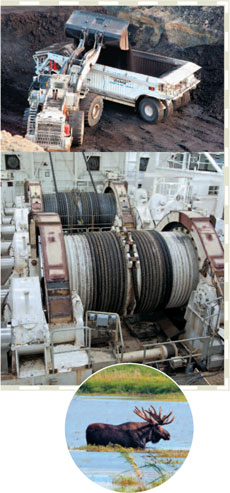
Outlook for 2012
NACoal remains focused on safety, environmental compliance and continuous improvement programs. These well-established programs provide a solid foundation for all of its coal and limerock mines. NACoal
expects improved operating performance at its coal mining operations in 2012. Tons delivered are expected to be slightly higher than 2011 provided customers achieve currently planned power plant operating levels. The company is optimistic the issues
affecting the power plant served by the Mississippi Lignite
Mining Company (“MLMC”) have been substantially resolved, returning MLMC to a more regular production state in 2012. However, some additional improvements to the power plant operations
are still expected during the upcoming year. The unconsolidated project mines are expected to have steady, or perhaps slightly increased, requirements in 2012. Limerock deliveries are expected to decrease modestly in 2012 as customer requirements
are expected to be lower as a result of the continued weakness in the southern Florida housing and construction markets. Royalty and other income in 2012 is expected to be moderately higher than 2011.
NACoal’s primary focus in 2012 is the execution and implementation of the projects it currently has in development. NACoal has
four mines in development stages that will not be in full production for several years but are expected to continue to generate modest income in 2012. Liberty Fuels is in the development phase and is eventually expected to produce approximately 4.8
million tons of lignite coal annually for Mississippi Power Company’s new Ratcliffe power plant currently being built in Mississippi. While completion of the project is still contingent on resolving legal challenges to regulatory approvals for
the power plant, the project is currently on track for initial deliveries to commence in early 2014. Caddo Creek Resources Company is in the permitting stage of a project in Texas for which it expects to mine approximately 650,000 tons of coal
annually for a customer that currently purchases its coal from The Sabine Mining Company. Initial deliveries are expected to commence in early 2014. Camino Real Fuels is in the permitting stage of a project in Texas for which it expects to mine
approximately 2.7 million tons of coal annually. The permitting process for this mine has been delayed and initial deliveries are now expected to commence in 2014. Finally, although Demery Resources Company has obtained its permit for a mine in
Louisiana that, at full production, is expected to provide approximately
300,000 to 400,000 tons of coal annually, unfavorable market conditions for its customer are expected to delay the commencement of deliveries at this operation to late 2012 or early 2013.
NACoal is working on several important new project opportunities domestically and internationally for which it expects to
continue to incur additional expenses in 2012. In particular, in the United States, the company continues to move forward to obtain a permit for its Otter Creek reserve in North Dakota in preparation for the expected construction of a new mine. The
permit is anticipated to be issued in the first half of 2012. NACoal is also performing work under a mining services agreement in India, which is designed to assist the customer in setting up and managing its mine.
Overall, NACoal expects net income in 2012 to increase compared with 2011 mainly as a result of expected improvements in tons delivered
at MLMC. However, higher selling, general and administrative expenses as a result of increased employee-related costs and development activities are expected to partially offset these improvements. Cash flow before financing activities in 2012 is
expected to be higher than 2011.
Longer-Term Perspective
NACoal expects to continue its record of operational excellence in safety, environmental stewardship and production at each of its mining operations and, over time, deliver profitability that exceeds its
financial objectives. In 2011, NACoal’s Sabine Mine received the prestigious “Sentinels of Safety” award, which is given annually to the nation’s safest mines with a minimum of 4,000 injury-free hours.
NACoal’s vision is to continue to be a leading low-cost miner of coal for its customers and to provide selected value-added mining
services for companies in the aggregates business. Over the longer term, NACoal expects to continue its efforts to develop new mining projects. NACoal has historically focused on domestic projects
TEN
|
|
|
|
|
|
|

|
|
and continues to actively pursue domestic opportunities for new coal mining projects. However, as the prospects for new coal projects in the United States are uncertain at best, the
company is looking for new opportunities to expand its global reach through mining activities that serve the international |
|
United States to continue to be competitive in a global economy. NACoal’s customers’ power plants are well-positioned in terms
of relative power costs, and NACoal expects that the company and its customers will be able to address effectively any anticipated changes to regulatory requirements.
NACoal also expects to continue to take a leadership role in helping ensure a reasonable mix of energy sources and appropriate
environmental responsibility. The company is actively associated with several organizations involved in evaluating |
|
HAMILTON BEACH
BRANDS 2011
Results Hamilton Beach Brands had disappointing
results in 2011. Revenues declined from $515.7 million in 2010 to $493.0 million in 2011 as the company was challenged during the year with lower unit sales volumes and reduced placements and promotions in the U.S. consumer retail market, mainly at
some of Hamilton Beach’s mass-market retail customers. Net income declined from $24.4 million in 2010 to $18.4 million in 2011 primarily as a result of the |
|
|
|
|
|
|
|
| mining arena in future years. NACoal is reviewing a number of international projects in India, Indonesia, Canada and China, as well as looking into |
|
and studying various clean-coal technologies, some of which are funded by the federal government. The company continues to
believe that new power plant technologies, such as integrated gasification combined cycle power generation, and production of alternative fuels made from coal, will provide important opportunities in the future.
Overall, NACoal anticipates reasonable long-term prospects for
global growth. Also, as the company’s new mines currently under construction commence operations, NACoal expects improved profitability over the long term. This enhanced financial performance is expected to provide a solid base for NACoal to
attain its long-term financial targets. |
|
effect of reductions in unit volumes and margin pressure from increased product costs. However, although Hamilton Beach was
able to return to an improved margin position during the second half of the year, that was not sufficient to counteract the significant decline in sales volumes.
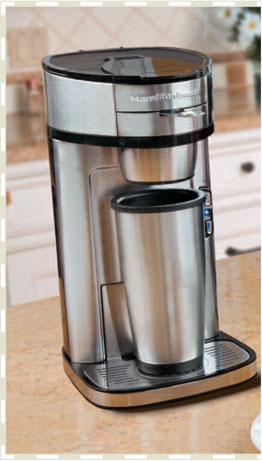
|
| opportunities to enter the export market. The company believes international projects structured similarly to those in the United States will provide an important
opportunity for growth.
New U.S. mining opportunities are expected to be more limited, with any
significant growth dependent on the United States adopting a balanced energy policy in which coal continues to play a key role. NACoal will continue to monitor pending regulations and legislation and may take a leadership role to help ensure that
reasonable actions are taken. The company believes that coal must remain an integral part of the nation’s total energy mix for the |
|
|
|

Top: The prestigious
“Sentinels of Safety” Award received by the Sabine Mining Company in 2011. Bottom: A truck/shovel operation uncovers coal in one of the pits at the Falkirk Mine. |
|
ELEVEN
While financial results were disappointing, HBB ended 2011 in a strong operational
position. HBB adjusted quickly to the lower sales levels and managed inventory and expenses carefully. The company generated improved cash flow before financing activities of $20.5 million, up from $12.8 million in 2010. The company was also able to
make a voluntary prepayment of $60 million on its term loan. In addition, HBB made solid strides in its execution of the company’s strategic goal to build up its global reach in the international retail and worldwide commercial businesses and
deliver strong improvements at several U.S. retailers. Unfortunately, these improvements were overshadowed by lost promotions and
placements at certain important retail partners.
Outlook for 2012
The middle-market portion of the small kitchen appliance market in which HBB participates weakened over the course of 2011 and is
expected to remain weak in 2012. It will be a challenge to increase placements, promotions and unit volume substantially at the mass-market retailers in the U.S. consumer market, especially since the company’s target consumer, the middle-market
mass consumer, continues to struggle with financial concerns and high unemployment rates. While sales volumes in this segment of the U.S.
consumer market are expected to remain under pressure, HBB is optimistic it will grow in 2012. International and commercial product markets are expected to remain strong, and this strength as
well as the company’s increase in resources and products allocated to these segments is expected to drive revenue growth in 2012.
HBB believes its focus on innovation, preferred brands and quality products is still the right strategy, and it will continue to focus on strengthening its market position through product innovation,
promotions,
HOUSEWARES
Hamilton Beach Brands’ newest products include, clockwise from left: Hamilton Beach® The Scoop™ single-serve coffee maker, Hamilton Beach® The Scoop™ 2-Way Brewer coffee maker, Proctor Silex® can opener, Proctor Silex®
two-slice toaster, Hamilton Beach® Durathon™ electronic nonstick iron
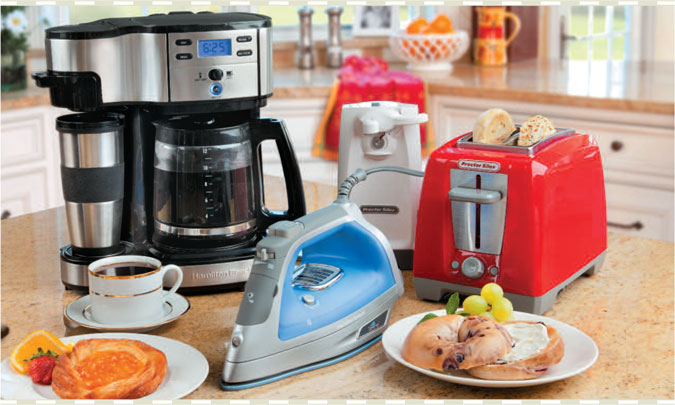
TWELVE

Top: The newest version of the Hamilton Beach® Stay or Go® 6 quart portable slow cooker
Center: Hamilton Beach® Big Mouth® Duo Plus food
processor
Bottom: Hamilton Beach® Belgian-Style waffle maker
increased placements and branding programs, together with appropriate levels of
advertising for the company’s highly successful and innovative product lines, such as The ScoopTM, a new single-serve coffee maker. Hamilton Beach’s line of
Melitta®-branded beverage appliances, introduced in late 2010, enhanced its position in 2011. In addition, The
ScoopTM and its family of products, as well as the new
DurathonTM iron product line, both introduced in late
2011, were well-received. HBB expects all of these products to continue to gain market position over time as broader distribution is attained. The company is
also continuing to introduce innovative products in several other small appliance categories. These products, as
well as other new product introductions in the pipeline for 2012 and future years, are expected to affect revenues and operating profit positively. However, as a result of the weak U.S. consumer market,
Hamilton Beach currently anticipates only a modest increase in 2012 revenues compared with 2011.
Overall, Hamilton Beach
expects 2012 net income to increase modestly compared with 2011. The company’s goal is to manage costs and expenses effectively while focusing on gaining placements to drive top-line growth. Nevertheless, product costs are expected to increase
modestly in the first half of 2012, but then level out for the second half of the year, while transportation costs are expected to increase in the second half of 2012. Hamilton Beach continues to monitor commodity costs closely and expects to adjust
product prices and placements as appropriate, if these costs increase more than anticipated. Hamilton Beach expects that 2012 cash flow before financing activities will be modestly lower than in 2011 as a result of increased working capital to fund
revenue growth.
Longer-Term Perspective
HBB will continue to focus on its areas of excellence – customer service, fact-based professional sales and marketing
and global sourcing. In addition, in 2012 and going forward, a critical focus for HBB will be to ensure the continued high quality of its global contract manufacturing. HBB will also continue to
invest in providing its customers innovative, quality products and value-added services throughout the middle market to ensure the company’s products remain a critical part of its customers’ assortment plans.
Important promotional campaigns designed to support HBB’s brands and new products are expected to continue. The company’s
product and placement track record continues to be robust due to innovation processes centered on understanding and meeting end-user needs. In the U.S. consumer market, HBB believes it has a stronger and deeper portfolio of new products than its
competitors and an industry-leading level of innovation, with
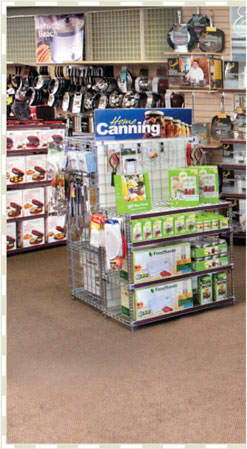
THIRTEEN
best-in-class brands and products. Because HBB delivered a meaningful increase in its product pipeline in 2011 and expects to maintain this increased level of new product platforms in 2012 and
beyond, the company believes it is well-positioned to deliver increased placements and promotions across the retail marketplace.
The company is focused on ensuring it remains a leading designer, marketer and distributor of small electric household and commercial products sold under strong brand names with innovative solutions that
improve everyday living and achieving growth profitably. Longer term, HBB will continue to work to increase revenues and profitability by gaining placements and promotions at its key U.S. consumer retailers. The company will also continue to work on
improving efficiencies, reducing costs, increasing pricing when needed and
pursuing strategic growth opportunities, including growth opportunities for the Hamilton Beach® and Proctor Silex® brands
through new product offerings and for the Melitta® brand with increased distribution, as well as other domestic
growth opportunities in the high-end consumer market. In addition, HBB will continue to pursue strategic growth opportunities in Canada, Latin America and other emerging markets, as well as in global commercial markets, which are expected to provide
above-average growth rates in 2012 and beyond. As a result, the company believes it is well-positioned to continue its leadership position in the small kitchen appliances industry and to move toward achieving its long-term financial objective of a
minimum 10 percent operating profit margin in the years ahead.
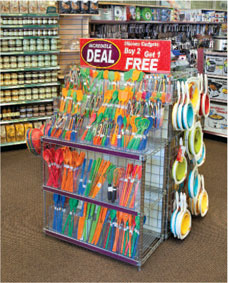
Above: A free-standing display at the Kitchen Collection® store in Chillicothe, Ohio.
Below: The newly formatted Kitchen Collection®
store in Chillicothe, Ohio, features bump outs to improve the display of products.
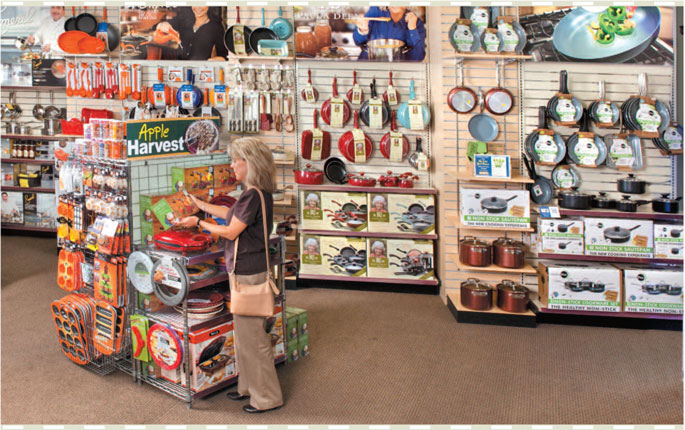
FOURTEEN
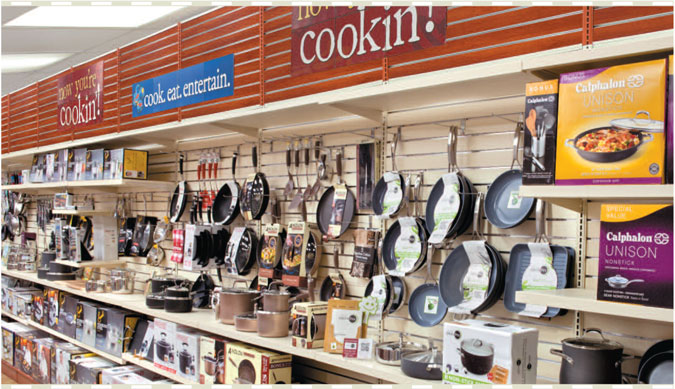
New display layouts and signage at Kitchen Collection’s Le Gourmet Chef® stores. Le Gourmet Chef® stores feature higher-margin, brand-name kitchenware and gourmet foods.
KITCHEN COLLECTION
2011 Results
Operationally in 2011, Kitchen Collection made solid strides in improving its Kitchen Collection® store format and progressed in its efforts to develop an improved Le Gourmet Chef® store format. While these operational improvements were encouraging, continued improvement is still necessary, primarily at the Le Gourmet Chef® store format. Unfortunately, these operational improvements did not translate into financial improvements in 2011.
The company experienced a very challenging first half of the year. Inclement weather and financial pressures weighing on middle-market consumers reduced customer visits to its stores. The company also incurred higher costs as it combined its two
distribution centers into one and invested
in closing underperforming stores and opening new Kitchen
Collection® stores. Kitchen Collection began to see gains from its investments during the fourth quarter and
benefited from favorable weather at year end. As a result, revenues increased from $219.6 million in 2010 to $221.2 million in 2011 as sales from new stores offset lost revenues from closed stores. However, net income and cash flow before financing
activities declined significantly as increased sales were not enough to offset the increased operating costs incurred early in the year. Net income decreased to $1.1 million in 2011 from $3.5 million in 2010 largely due to lower comparable store
results caused by a shift in sales to lower margin products and costs incurred as a result of combining the distribution centers. Cash flow before financing activities declined to $2.6 million in 2011 from $3.6 million in 2010.
The Kitchen Collection® stores, which sell a wide variety of basic kitchen items, generated an increase in sales, sales transactions and an
increased average sales transaction value despite reduced customer visits. This store format benefited from a refreshed store format rolled out to certain key locations with improved product assortments and enhanced merchandising. However, lower
gross margins, higher employee-related costs and unfavorable comparable store results reduced Kitchen
Collection® store income compared with the prior year. The Le Gourmet Chef® stores, which sell higher-end goods focusing on cooking and entertaining themes, struggled in 2011. A higher average
sales transaction value did not make up for fewer transactions and reduced customer visits, largely driven by having fewer stores open in 2011 than in 2010. Improvements were made to
FIFTEEN
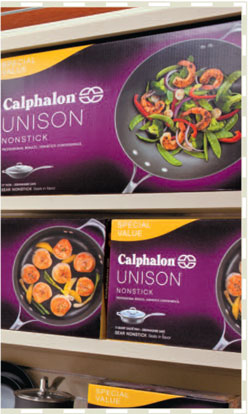
the Le Gourmet Chef® format and layout, but these improvements were not fully implemented by the end of 2011. Operationally, Kitchen Collection ended the year with enhanced store formats,
which are expected to improve performance in 2012, especially when customer visits improve.
Outlook for 2012
Uncertainty in the economy, high unemployment rates and rising fuel prices, along with other consumer financial
concerns, are expected to continue to affect consumer sentiment and limit spending levels for Kitchen Collection’s target customer, prolonging a challenging retail environment in 2012. However, the company expects to have an increased number of
Kitchen Collection® stores in 2012. As a result, Kitchen Collection expects revenue in 2012 to increase compared
with 2011.
Overall, Kitchen Collection expects a modest increase in 2012 net
income and cash flow before financing activities compared with 2011 primarily as a result of an increase in the number of Kitchen Collection® stores opened throughout 2011 and new stores expected to be opened in 2012, including some mall-based stores with a smaller footprint and lower rent. Kitchen
Collection expects the momentum achieved by the new stores in the fourth quarter of 2011 to continue in 2012 and expects improvements in operating results as new stores opened in 2011 gain traction and additional new stores are opened in 2012. In
addition, Kitchen Collection anticipates improvements in operating results as the company continues its disciplined program of closing underperforming stores.
Enhanced sales and margins are also expected as a result of further improvements in the company’s store
formats and layouts at both the Kitchen Collection® and Le Gourmet Chef® stores as a result of further refinements of its promotional offers and merchandise mix in both store formats. In
2011, Kitchen Collection® tested a refreshed layout and achieved positive performance with this prototype. The
new layout will be rolled out to a large portion of the stores in 2012. In addition, during the year, the company invested significant time and resources in developing a Le Gourmet Chef® prototype that is anticipated to enhance profit prospects. Initial results are encouraging, and the new prototype, with an improved product assortment, is expected to
be rolled out to all stores during 2012. In addition to the new formats, Kitchen Collection has also created value and trend messaging specific to each store format to enhance sales. Finally, the renegotiation of store leases and the combination of
Kitchen Collection’s two distribution centers into one larger, more efficient facility, as well as the absence of a number of costs incurred in 2011 but not expected to recur in 2012, are also expected to contribute to improved results.
Although the company anticipates increased product and transportation costs
in 2012, it expects to offset these increased costs through price increases and other actions as needed.
Longer-Term Perspective
Kitchen Collection’s
vision is to be the leading specialty retailer of kitchen, home entertaining and gourmet food products in outlet malls and other retail channels for consumers seeking a large selection of unique, high-quality products at exceptional value. It
sources products globally from China, Taiwan, Indonesia, Vietnam and India, as well as North America. The company’s core strength is its Kitchen Collection® store format in outlet malls, but it has two solid store formats and plans to leverage this strength with strong, separate brand identities for each.
The Kitchen Collection® store format is strong and Le Gourmet
Chef® continues to improve. Going forward, management’s plans for revenue and profitability growth will
focus on further strengthening its merchandise mix, store displays and appearance, optimizing store selling space, evaluating and closing underperforming and loss-generating stores as lease contracts permit and maintaining disciplined cost control.
The company also plans to expand the number of outlet malls in which Kitchen Collection® and Le Gourmet Chef® operate and to optimize store footprint sizes to enhance its ability to achieve target profit levels. The company
also plans to continue to work on refining a traditional mall approach for both store formats which focuses on a smaller store footprint and which takes advantage of open locations and lower rents. In the near term, expansion will be focused on the
Kitchen Collection® format. When adequate profit prospects are demonstrated for the Le Gourmet Chef® format, focus will shift to growth in the number of these stores.
With improvements already implemented or in planning, the Kitchen Collection® stores are expected to achieve higher margins in 2012, but are still not expected to achieve the long-term operating
margin target of 5 percent until 2014. Le Gourmet Chef® stores are not expected
SIXTEEN
to achieve target margins until sales volumes increase and additional under-performing stores have been closed.
Conclusions and NACCO Outlook
NACCO and its subsidiaries’ efforts
to increase revenues and reduce costs are affected by the global economic environment. While the economic environment in the United States continues to improve, uncertainties still remain, especially in Europe. In addition, specific markets for
NACCO’s subsidiaries are moderating or uncertain at this time. Each subsidiary is proceeding carefully and monitoring economic and market conditions closely, while remaining focused on its programs for improving financial results and achieving
its minimum financial goals. While NMHG, HBB and Kitchen Collection did not meet their minimum financial goals in 2011 and NACoal met only its ROTCE goal, NACCO’s companies benefited from strong improvement programs put in place and are
confident that they are solidly positioned for market improvements. These programs will enable the subsidiary companies to continue to move toward achievement of all the minimum financial objectives, enhance the strong ROTCE results at NMHG, HBB and
NACoal and reach acceptable levels at Kitchen Collection.
In 2012, overall consolidated results are expected to decrease
compared with 2011, excluding the Applica settlement,
primarily because of a decrease at NMHG as a result of an anticipated shift in sales mix to lower-margin markets, higher marketing costs and adverse foreign currency movements. Improvement is
expected at HBB as it focuses on top-line growth through placements and promotions. Improved results are expected at Kitchen Collection as new stores gain traction and the company focuses on improving the profitability of its Le Gourmet Chef® stores. Finally, an expected increase in tons delivered and a higher level of production at MLMC are expected to
lead to improved results at NACoal.
NACCO plans to continue to focus on maximizing cash flow before financing activities in
2012 and in future years, with an increase in cash flow before financing activities anticipated for 2012 in comparison to 2011, despite an expected increase in capital expenditures at NMHG and Kitchen Collection. In general, future capital
expenditures are expected to be modest relative to cash flow in the years ahead unless new growth opportunities develop.
NACCO continues to have great confidence in the management teams leading each of the Company’s subsidiaries. These many
experienced and highly motivated professionals worked successfully to overcome challenges and deliver the Company’s strong financial results in 2011.

In closing, we would like to recognize the outstanding contributions over the past 18
years of Owsley Brown II, who passed away last fall. He will be greatly missed by NACCO’s Directors and employees.
We
would also like to welcome General John P. Jumper to the NACCO Board of Directors. General Jumper is currently Chief Executive Officer of SAIC, a government technology solutions company. He retired in 2005 from the United States Air Force after a
distinguished 39-year career, including service as the 17th Chief of Staff of the United States Air Force. Prior to assuming the position of Chief of Staff, General Jumper served as Commander of Air Combat Command at Langley Air Force Base,
Virginia. He also served at the Pentagon as Deputy Chief of Staff for Air and Space Operations, as the Senior Military Assistant to two Secretaries of Defense and as Special Assistant to the Chief of Staff for Roles and Missions. We are privileged
to have him join us as a Director.
Finally, we would like to take this opportunity to thank all of our subsidiaries’
customers, retailers, dealers and suppliers and all NACCO stockholders for their continued support. We would also like to thank all NACCO and subsidiary employees most sincerely for their continued hard work and commitment to achieving the successes
and meeting the challenges of 2011. We look forward to working together for a successful 2012.

Alfred M. Rankin, Jr.
Chairman, President and
Chief Executive Officer,
NACCO Industries, Inc.

Robert L. Benson
President and Chief Executive Officer,
The North American Coal Corporation

Michael P. Brogan
President and Chief Executive Officer,
NACCO Materials Handling Group, Inc.

Gregory H. Trepp
President and Chief Executive Officer,
Hamilton Beach Brands, Inc.
Chief Executive Officer,
The Kitchen
Collection, LLC

Richard R. Chene, Jr.
President, The Kitchen Collection, LLC
SEVENTEEN
SUPPLEMENTAL DATA
Reconciliation of 2011 and 2010 Consolidated Net Income attributable to stockholders “As reported” to Adjusted Income attributable to
stockholders:
|
|
|
$00,000 |
|
|
|
$00,000 |
|
| |
|
(In millions, except per share data) |
|
| |
|
2011 |
|
|
Diluted earnings
per share |
|
| 2011 Consolidated Net Income attributable to stockholders, as reported |
|
$ |
162.1 |
|
|
$ |
19.28 |
|
| Impact of Applica settlement, after taxes of $21.0 |
|
|
(39.0 |
) |
|
|
(4.64 |
) |
| Impact of Applica litigation costs, after taxes of $1.0 |
|
|
1.8 |
|
|
|
0.21 |
|
|
|
|
|
|
|
|
|
|
| 2011 Adjusted Income attributable to stockholders |
|
$ |
124.9 |
|
|
$ |
14.85 |
|
|
|
|
|
|
|
|
|
|
|
|
|
$00,000000 |
|
|
|
$00,000000 |
|
| |
|
2010 |
|
|
Diluted earnings
per share |
|
| 2010 Consolidated Net Income attributable to stockholders, as reported |
|
$ |
79.5 |
|
|
$ |
9.53 |
|
| Impact of Applica litigation costs, after taxes of $6.6 |
|
|
12.2 |
|
|
|
1.46 |
|
|
|
|
|
|
|
|
|
|
| 2010 Adjusted Income attributable to stockholders |
|
$ |
91.7 |
|
|
$ |
10.99 |
|
|
|
|
|
|
|
|
|
|
Adjusted Income attributable to stockholders is a measure of income that differs from Net Income attributable to
stockholders measured in accordance with U.S. GAAP. The Company has reported adjusted income and earnings per diluted share for the years ended December 31, 2011 and 2010 excluding the net effect of the Applica settlement and related litigation
costs. Management believes a discussion excluding the settlement and litigation costs is more reflective of NACCO’s underlying business operations and enables investors to better understand the results of operations of the Company.
|
|
|
$00,00 |
|
|
|
$00,00 |
|
|
|
$00,00 |
|
|
|
$00,00 |
|
|
|
$00,00 |
|
| Calculation of Return on Capital Employed: |
|
(In millions, except percentage data) |
|
| 2011 |
|
NMHG |
|
|
HBB |
|
|
Kitchen
Collection |
|
|
NACoal |
|
|
NACCO
Consolidated |
|
| 2011 Average Equity (12/31/2010 and each of 2011’s quarter ends) |
|
$ |
272.5 |
|
|
$ |
22.3 |
|
|
$ |
43.2 |
|
|
$ |
133.8 |
|
|
$ |
526.2 |
|
| 2011 Average Debt (12/31/2010 and at each of 2011’s quarter ends) |
|
|
229.1 |
|
|
|
90.6 |
|
|
|
7.6 |
|
|
|
51.9 |
|
|
|
379.1 |
|
| 2011 Average Cash (12/31/2010 and at each of 2011’s quarter ends) |
|
|
(152.2 |
) |
|
|
(34.8 |
) |
|
|
(5.1 |
) |
|
|
(2.7 |
) |
|
|
(273.9 |
) |
|
|
|
|
|
|
|
|
|
|
|
|
|
|
|
|
|
|
|
|
|
| 2011 Average capital employed, net of cash |
|
$ |
349.4 |
|
|
$ |
78.1 |
|
|
$ |
45.7 |
|
|
$ |
183.0 |
|
|
$ |
631.4 |
|
|
|
|
|
|
|
| 2011 Net income, as reported |
|
$ |
82.6 |
|
|
$ |
18.4 |
|
|
$ |
1.1 |
|
|
$ |
29.4 |
|
|
$ |
162.1 |
|
| Less: Applica settlement, after taxes of $21.0 million |
|
|
— |
|
|
|
— |
|
|
|
— |
|
|
|
— |
|
|
|
(39.0 |
) |
| Plus: Applica litigation costs, after taxes of $1.0 million |
|
|
— |
|
|
|
— |
|
|
|
— |
|
|
|
— |
|
|
|
1.8 |
|
| Plus: 2011 Interest expense, as reported |
|
|
15.8 |
|
|
|
5.2 |
|
|
|
0.5 |
|
|
|
3.0 |
|
|
|
24.5 |
|
| Less: Income taxes on 2011 interest expense at 38%* |
|
|
(6.0 |
) |
|
|
(2.0 |
) |
|
|
(0.2 |
) |
|
|
(1.1 |
) |
|
|
(9.3 |
) |
|
|
|
|
|
|
|
|
|
|
|
|
|
|
|
|
|
|
|
|
|
| Return on capital employed |
|
$ |
92.4 |
|
|
$ |
21.6 |
|
|
$ |
1.4 |
|
|
$ |
31.3 |
|
|
$ |
140.1 |
|
|
|
|
|
|
|
|
|
|
|
|
|
|
|
|
|
|
|
|
|
|
| Return on capital employed percentage |
|
|
26.4 |
% |
|
|
27.7 |
% |
|
|
3.1 |
% |
|
|
17.1 |
% |
|
|
22.2 |
% |
|
|
|
|
|
|
|
|
|
|
|
|
|
|
|
|
|
|
|
|
|
|
|
|
$00,00 |
|
|
|
$00,00 |
|
|
|
$00,00 |
|
|
|
$00,00 |
|
|
|
$00,00 |
|
| 2010 |
|
NMHG |
|
|
HBB |
|
|
Kitchen
Collection |
|
|
NACoal |
|
|
NACCO
Consolidated |
|
| 2010 Average Equity (12/31/2009 and each of 2010’s quarter ends) |
|
$ |
210.5 |
|
|
$ |
(1.8 |
) |
|
$ |
43.5 |
|
|
$ |
137.9 |
|
|
$ |
406.1 |
|
| 2010 Average Debt (12/31/2009 and at each of 2010’s quarter ends) |
|
|
239.9 |
|
|
|
115.7 |
|
|
|
3.3 |
|
|
|
42.7 |
|
|
|
404.6 |
|
| 2010 Average Cash (12/31/2009 and at each of 2010’s quarter ends) |
|
|
(164.3 |
) |
|
|
(45.5 |
) |
|
|
(4.6 |
) |
|
|
(4.6 |
) |
|
|
(247.5 |
) |
|
|
|
|
|
|
|
|
|
|
|
|
|
|
|
|
|
|
|
|
|
| 2010 Average capital employed, net of cash |
|
$ |
286.1 |
|
|
$ |
68.4 |
|
|
$ |
42.2 |
|
|
$ |
176.0 |
|
|
$ |
563.2 |
|
|
|
|
|
|
|
| 2010 Net income, as reported |
|
$ |
32.4 |
|
|
$ |
24.4 |
|
|
$ |
3.5 |
|
|
$ |
39.6 |
|
|
$ |
79.5 |
|
| Plus: Applica litigation costs, after taxes of $6.6 million |
|
|
— |
|
|
|
— |
|
|
|
— |
|
|
|
— |
|
|
|
12.2 |
|
| Plus: 2010 Interest expense, as reported |
|
|
16.6 |
|
|
|
7.2 |
|
|
|
0.3 |
|
|
|
3.3 |
|
|
|
27.4 |
|
| Less: Income taxes on 2010 interest expense at 38%** |
|
|
(6.3 |
) |
|
|
(2.7 |
) |
|
|
(0.1 |
) |
|
|
(1.3 |
) |
|
|
(10.4 |
) |
|
|
|
|
|
|
|
|
|
|
|
|
|
|
|
|
|
|
|
|
|
| Return on capital employed |
|
$ |
42.7 |
|
|
$ |
28.9 |
|
|
$ |
3.7 |
|
|
$ |
41.6 |
|
|
$ |
108.7 |
|
|
|
|
|
|
|
|
|
|
|
|
|
|
|
|
|
|
|
|
|
|
| Return on capital employed percentage |
|
|
14.9 |
% |
|
|
42.3 |
% |
|
|
8.8 |
% |
|
|
23.6 |
% |
|
|
19.3 |
% |
|
|
|
|
|
|
|
|
|
|
|
|
|
|
|
|
|
|
|
|
|
Return on capital employed is provided solely as a supplemental disclosure with respect to income generation because
management believes it provides useful information
with respect to earnings in a form that is comparable to the Company’s cost of
capital employed, which includes both equity and debt securities, net of cash.
| * |
Tax rate of 38% represents the Company’s target marginal tax rate compared with 2011’s effective income tax rate of 24.2%. |
| ** |
Tax rate of 38% represents the Company’s target marginal tax rate compared with 2010’s effective income tax rate of 18.0%. |
EIGHTEEN
OFFICERS AND DIRECTORS
Officers and Directors of
NACCO Industries, Inc.
Officers:
Alfred M. Rankin, Jr.
Chairman, President
and Chief Executive Officer
Charles A. Bittenbender
Vice President, General Counsel
and Secretary
J.C. Butler, Jr.
Vice President-Corporate Development
and Treasurer
Mary D. Maloney
Assistant General Counsel
and Assistant Secretary
Lauren E. Miller
Vice President-Consulting Services
Kenneth C. Schilling
Vice President and Controller
Suzanne S. Taylor
Associate General Counsel and
Assistant Secretary
Directors:
John P.
Jumper
Chief Executive Officer, SAIC
Retired Chief of Staff,
United States Air Force
Dennis W. LaBarre
Partner, Jones Day
Richard de J. Osborne
Retired Chairman and Chief Executive
Officer, ASARCO Incorporated
Alfred M. Rankin, Jr.
Chairman, President and Chief Executive
Officer, NACCO Industries, Inc.
Michael E. Shannon
President, MEShannon & Associates, Inc.
Retired Chairman, Chief Financial and
Administrative Officer, Ecolab, Inc.
Britton T. Taplin
Self employed (personal investments)
David F. Taplin
Self employed (tree farming)
John F. Turben
Founding Partner,
Kirtland Capital Partners
Eugene Wong
Professor Emeritus,
University of California at Berkeley
Officers of Subsidiaries
Officers of NACCO Materials
Handling Group, Inc.
Corporate:
Alfred M. Rankin, Jr.
Chairman
Michael P. Brogan
President and Chief Executive Officer
Colin Wilson
Vice President and Chief Operating Officer
and President, Americas
Lauren E. Miller
Senior Vice President, Marketing
and Consulting
Kenneth C. Schilling
Vice President and Chief Financial Officer
Charles A. Bittenbender
Vice President, General Counsel
and Secretary
Rajiv K. Prasad
Vice President, Global Product Development
and Manufacturing
Victoria L. Rickey
Vice President, Asia-Pacific
Michael E. Rosberg
Vice President, Global Supply Chain
Gopi Somayajula
Vice President, Counterbalanced
Engineering
J.C. Butler, Jr.
Treasurer
Jennifer M. Langer
Controller
Americas:
Donald L. Chance, Jr.
Vice President, President, NMHG Sales
Raymond C. Ulmer
Vice President, Finance Americas
Europe, Africa and Middle East:
Ralf A. Mock
Managing Director, Europe, Africa
and Middle East
Asia-Pacific:
Nobuo Kimura
President, Sumitomo NACCO Materials
Handling Co., Ltd.
Officers of Hamilton Beach
Brands, Inc.
Alfred M. Rankin, Jr.
Chairman
Gregory H. Trepp
President and Chief Executive Officer
Gregory E. Salyers
Senior Vice President, Global Operations
R. Scott Tidey
Senior Vice President, North America
Sales and Marketing
Keith B. Burns
Vice President, Engineering and
Information Technology
Kathleen L. Diller
Vice President, General Counsel
and Secretary
James H. Taylor
Vice President and Chief Financial Officer
Richard E. Moss
Senior Director, Finance & Treasurer
Officers of The Kitchen
Collection, LLC
Alfred M. Rankin, Jr.
Chairman
Gregory H. Trepp
Chief Executive Officer
Richard R. Chene, Jr.
President
Randy L. Sklenar
Vice President-Field Operations and
Human Resources
Karen E. Cavender
Controller
L.J. Kennedy
Secretary and Treasurer
Officers of The North American
Coal
Corporation
Alfred M. Rankin, Jr.
Chairman
Robert L. Benson
President and Chief Executive Officer
J.C. Butler, Jr.
Senior Vice President-Project Development
and Administration
Bob D. Carlton
Vice President and Chief Financial Officer
Michael J. Gregory
Vice President-International Operations
and Special Projects
Thomas A. Koza
Vice President, Senior Counsel and
Assistant Secretary
John D. Neumann
Vice President, General Counsel
and Secretary
Harry B. Tipton III
Vice President-Engineering, and Louisiana
and Mississippi
Operations
K. Donald Grischow
Treasurer
John R. Pokorny
Controller
CORPORATE INFORMATION
Annual Meeting
The Annual Meeting of Stockholders of NACCO Industries, Inc. will be held on May 9, 2012, at 9:00 a.m. at the corporate office located at: 5875 Landerbrook Drive, Cleveland, Ohio 44124
Form 10-K
Additional
copies of the Company’s Form 10-K filed with the Securities and Exchange Commission are available free of charge through NACCO Industries’ website (www.nacco.com) or by request to:
Investor Relations
NACCO Industries, Inc.
5875 Landerbrook Drive, Suite 300
Cleveland, Ohio 44124
(440) 449-9669
Stock Transfer Agent and Registrar
Computershare
250 Royall Street
Canton, Massachusetts 02021
(800) 622-6757
Legal Counsel
Jones
Day
North Point
901 Lakeside Avenue
Cleveland, Ohio 44114
Independent Registered Public
Accounting Firm
Ernst & Young LLP
1300 Huntington Building
925 Euclid Avenue
Cleveland, Ohio 44115
Stock Exchange Listing
The New York Stock Exchange
Symbol: NC
Investor Relations Contact
Investor questions may be addressed to:
Investor Relations
NACCO Industries, Inc.
5875 Landerbrook Drive, Suite 300
Cleveland, Ohio 44124
(440) 449-9669
E-mail: ir@naccoind.com
NACCO Industries Website
Additional information on NACCO Industries may be found at the corporate website, www.nacco.com. The Company considers this
website to be one of the primary sources of information for investors and other interested parties.
Subsidiary Company Websites
The websites of several subsidiary
companies and their brands can be found
at the following locations:
NACCO Materials Handling Group:
www.nmhg.com
Hyster Global:
www.hyster.com
Hyster North America:
www.hysteramericas.com
Hyster Europe:
www.hyster.co.uk
Hyster Asia-Pacific:
www.hyster.com.au
Hyster China:
www.hyster.com.cn
Yale Global:
www.yale.com
Yale North America:
www.northamerica.yale.com
Yale Latin America:
www.southamerica.yale.com
Yale Europe:
www.yale-forklifts.eu
Yale Asia-Pacific:
www.yale.com.au
UTILEV:
www.utilev.com
Hamilton Beach Brands–U.S.:
www.hamiltonbeach.com
www.proctorsilex.com
www.commercial.hamiltonbeach.com
Hamilton Beach Brands–Mexico:
www.hamiltonbeach.com.mx
Kitchen Collection:
www.kitchencollection.com
www.legourmetchef.com
North American Coal:
www.nacoal.com
Environmental
Benefits
This Annual Report on Form 10-K is printed using post-consumer waste recycled paper and vegetable-based inks.
By using this environmental paper, NACCO Industries, Inc. saved the following resources:
The FSC Trademark identifies wood fibers coming from forests which have been certified in accordance with the rules of
the Forest Stewardship Council.








































